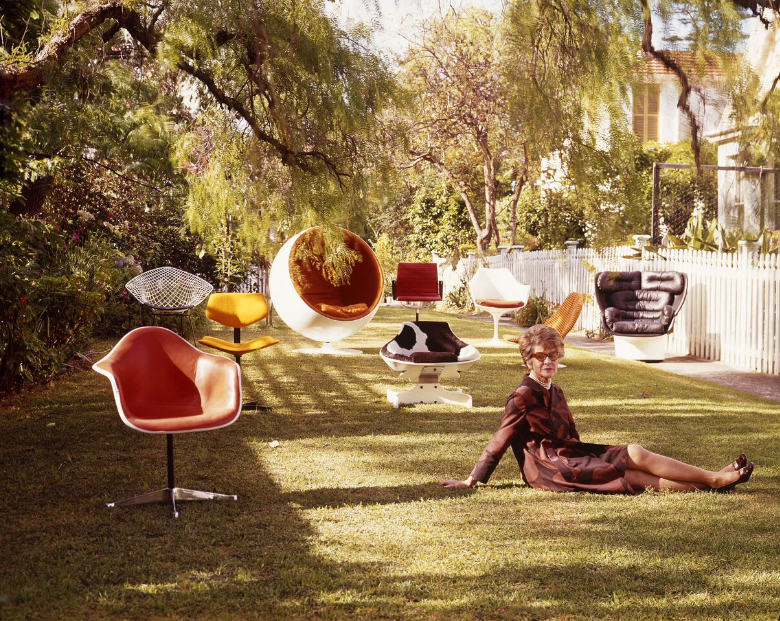-

Marion Hall Best with chairs by designers Andrews, Arnio, Saarinen, Colombo, Eames and Bertoia at The Grove, Woollahra, 1970. Caroline Simpson Library & Research Collection, Sydney Living Museums. Photo © Mary White
We speak to Michael Lech, the curator of an upcoming exhibition celebrating the work of Australian interior designer legend Marion Hall Best.
Marion Hall Best was an Australian 20th century interior design legend, who was known for her love and adventurous use of bold colour and print (matched in equal part by her intense disdain for beige).
Over the course of her career, particularly between the 1930s to 1970s, Best introduced many Australians to Modernist design through importing furniture, design, textiles and interiors by talented local and international designers and artists, and even designed a few pieces of her own. She undertook both commissioned private and corporate works and operated two stores that redefined Australian interiors – her colourful workshop and retail store, Marion Best Fabrics, in Woollahra (which traded from 1938 to 1974), and the small store she opened in Sydney’s CBD in 1949.
An upcoming exhibition, ‘Marion Hall Best: Interiors’, at the Museum of Sydney celebrates her work and contribution to Australian design. We spoke to its curator Michael Lech to learn more.
How would you describe Marion Hall Best’s style?
When Marion Best began her career in the mid-late 1930s, her style would be described as ‘modern’. Her interiors were not unlike other modern spaces around the world – by contrast, period interiors were very popular in the 1920s. In all these ‘modern’ interiors, there was a desire for simplified spaces, less ornament, a harmony or balance of furnishings. Throughout her career, she was influenced by Modernism – colour, form, volume, movement – but she also developed her own style. There was definitely a style she evolved that was unlike anyone else, both nationally and internationally.
Best had an artist’s eye for colour and form and was continually inspired by artists and sculptors. She believed that strong, bold colours could stimulate creativity and thought; while pastels and insipid colours were deadening to the mind and body.
Best was excited by good design and was taken with the latest international Modernist furniture and furnishings being developed after World War II. She travelled overseas herself many times to meet manufacturers, designers and suppliers and imported many Modernist furnishings into Australia and sold them in her shop – she was often the first to use them in her interiors. By the 1960s, the furniture and furnishings she used came from around the globe, such as Cassina furniture and Flos lighting from Italy, McGuire, Knoll and Herman Miller furniture from the USA, Marimekko printed cottons and Iittala glass and lights from Finland, a variety of Scandinavian glassware and ceramics, Danish woollen textiles, Jim Thompson silks from Thailand, and cottons from India, which were made to Best’s own colour specifications.

‘A room for Mary Quant’ (Rooms on view, 1967). Caroline Simpson Library & Research Collection, Sydney Living Museums. © Mary White
How is this explored in the ‘Marion Hall Best: Interiors’ exhibition?
Marion Best’s style is explored in the exhibition through images of her work together with original furniture and furnishings she used in her schemes. The exhibition is a chronological exploration of her career from the mid-1930s to the mid-1970s.
We have attempted to make the exhibition exciting, to match the thrill that Best herself inspired in her interiors. We have not attempted to replicate her original interiors, but through the display of furniture and furnishings she used and of original images of interiors, to highlight some of the work she did.

Marion Hall Best in Marimekko, 1968. Caroline Simpson Library & Research Collection, Sydney Living Museums. Photo © Rodney Weidland
How would you describe Best’s legacy?
The staff who worked for Marion Best were often swept up in her excitement about colour and design and they then applied what they learnt in their own successful careers. Best is also now an essential part of the story of Modernism in Australia: her legacy having a direct connection to the artists of the interwar period like Thea Proctor, Roy de Maistre and Roland Wakelin. (See, for examples, books like Modern times: the untold story of Modernism in Australia, edited by Ann Stephen, Philip Goad and Andrew McNamara, 2008).
However, Best’s main legacy may be that she helped (and still helps) Australians to see interiors and design in a different way and allowed us all to see ample possibilities for improving our material or constructed world. She believed in the Arts & Crafts philosophy that through good design of ordinary everyday objects, our lives could be improved and our ability to be creative enhanced. In other words, we do not need to be content with second best in our visual surroundings.
The ‘Marion Hall Best: Interiors’ is on at the Museum of Sydney from August 5 to November 12. Curator Michael Lech will be hosting an exhibition talk from 2pm till 3pm on August 7.

A room for Mr Peter Sculthorpe, designed by Marion Best and Deirdre Broughton for the Rooms on View 1971 exhibition to celebrate SIDA’s 20th anniversary. Caroline Simpson Library & Research Collection, Sydney Living Museums. Photo © Michael Andrews